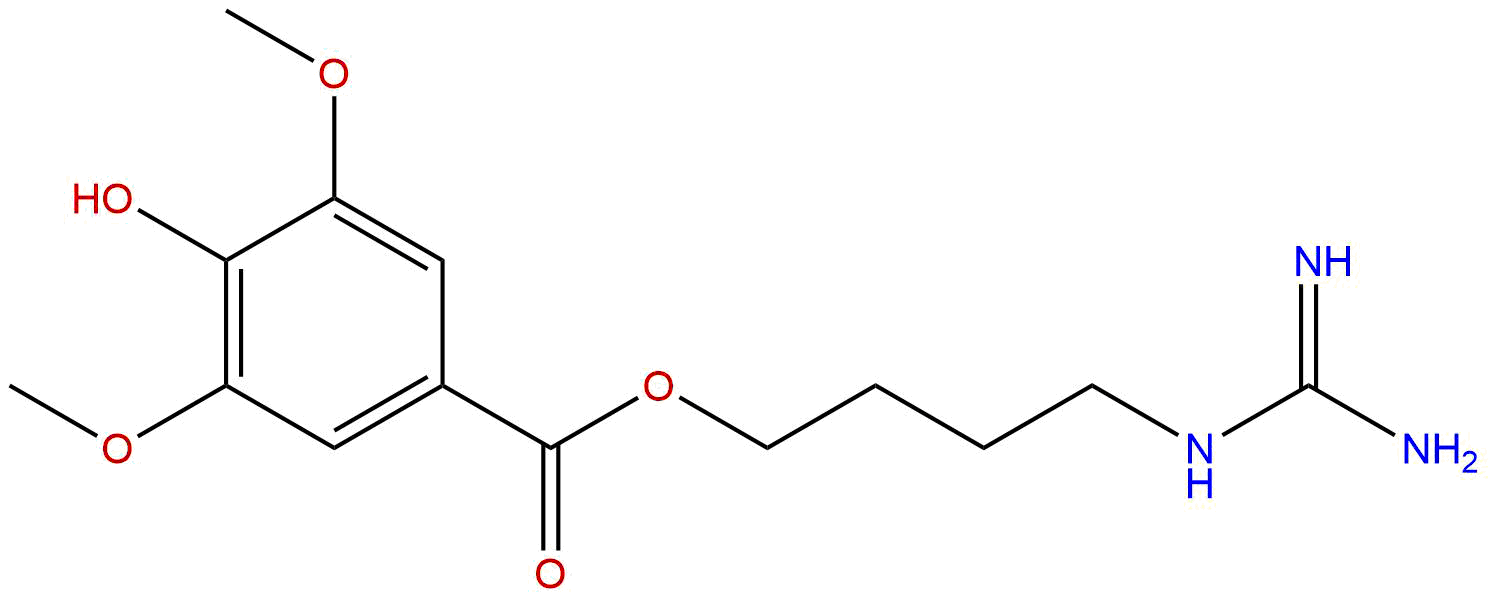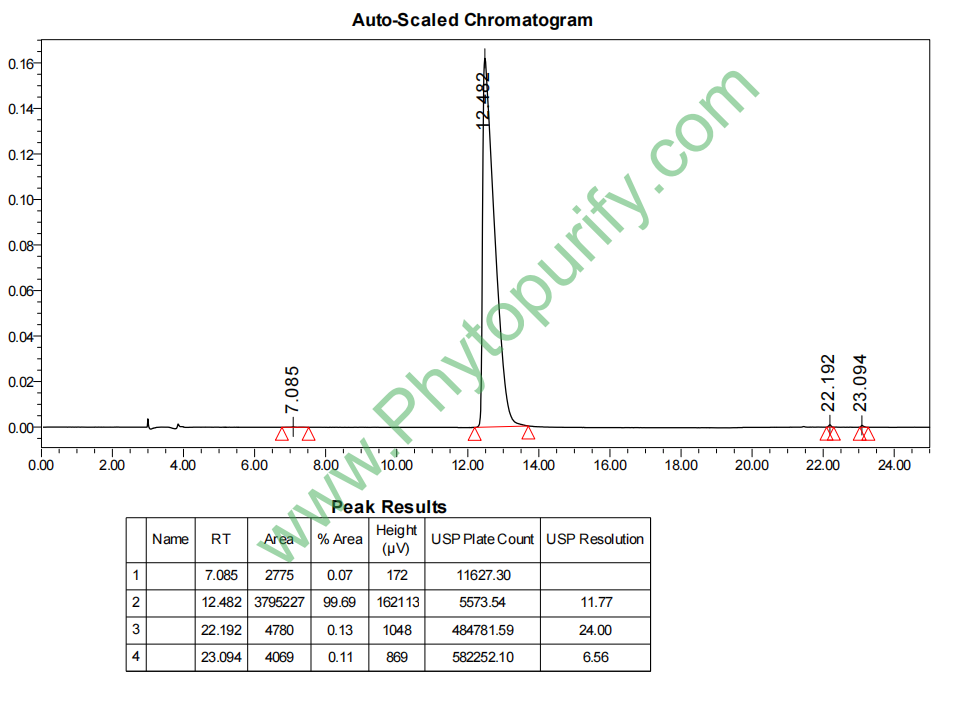
LeonurineCAS No.:24697-74-3 |
||||||||||
 |
|
|
||||||||

| Catalogue No.: | BP0850 |
| Formula: | C14H21N3O5 |
| Mol Weight: | 311.338 |
| Botanical Source: | Leonurus ja ponicus Houtt. |
Synonym name: 4-Guanidinobutyl syringate
Catalogue No.: BP0850
Cas No.: 24697-74-3
Formula: C14H21N3O5
Mol Weight: 311.338
Botanical Source: Alkaloid from Leonurus artemisia (a Chinese herbal medicine used in obstetrics) and Leonurus sibiricus (Labiatae)
Purity: 95%~99%
Analysis Method: HPLC-DAD or/and HPLC-ELSD
Identification Method: Mass, NMR
Packing: Brown vial or HDPE plastic bottle
Can be supplied from milligrams to grams.
For Reference Standard and R&D, Not for Human Use Directly.
Inquire for bulk scale.
Description:
Leonurine hydrochloride has anti-oxidative, anti-inflammatory, and antitumor activities, it exerts antidiabetic, cardiovascular, and bovine mastitis protection, it has an inhibitory effect on bleeding caused by incomplete abortion. Leonurine hydrochloride increases the expression levels of caspase-3, caspase-9 and Bax/Bcl-2, and it inhibits osteoclastogenesis and prevent osteoporosis associated with estrogen deficiency by inhibiting the NF-κB and PI3K/Akt signaling pathways.
References:
Bone. 2015 Jun;75:128-37.
Leonurine hydrochloride inhibits osteoclastogenesis and prevents osteoporosis associated with estrogen deficiency by inhibiting the NF-κB and PI3K/Akt signaling pathways.
Osteoclasts, the primary bone resorbing cells, are responsible for destructive bone diseases such as postmenopausal osteoporosis, rheumatoid arthritis, and periodontitis. Many plant-derived traditional medicines that might suppress the formation and/or function of osteoclasts are promising treatments for osteoclast-related diseases.
METHODS AND RESULTS:
In this study, we investigated the effects of Leonurine hydrochloride (LH) on receptor activator NF-κB ligand (RANKL)-induced osteoclastogenesis and ovariectomy-induced bone loss. Leonurine hydrochloride is a synthetic chemical compound based on the structure of leonurine, which is found in motherwort and has been reported to exhibit phytoestrogenic activity. In RAW 264.7 cells and mouse bone marrow monocytes (BMMs), Leonurine hydrochloride suppressed RANKL-induced osteoclastogenesis and actin ring formation in a dose-dependent manner. Leonurine hydrochloride targeted RANKL-induced osteoclastogenesis and bone resorption at an early stage. Molecular analysis demonstrated that Leonurine hydrochloride attenuated RANKL-induced NF-κB signaling by inhibiting the phosphorylation and degradation of IκBα and NF-κB p65 nuclear translocation. Leonurine hydrochloride inhibited the RANK-TRAF6 association triggered by RANKL binding and the phosphatidylinositol 3-kinase (PI3K)/Akt axis, without significantly affecting the extracellular signal-regulated kinase (ERK)/mitogen-activated protein kinase (MAPK) and AP-1 signaling pathways. Leonurine hydrochloride attenuated the RANKL-stimulated expression of osteoclast-related genes including NFATc1, tartrate resistant acid phosphatase (TRAP), cathepsin K, and osteoclast-associated receptor (OSCAR). Consistent with the in vitro results, Leonurine hydrochloride administration attenuated osteoclast activity, thus preventing bone loss caused by estrogen deficiency in mice. In this study, Leonurine hydrochloride suppressed RANKL-induced osteoclastogenesis via RANK-TRAF6, NF-κB, and PI3K/Akt signaling.
CONCLUSIONS:
These data provide the first evidence that Leonurine hydrochloride might be a promising therapeutic compound to treat osteoclast-related diseases, such as osteoporosis.
Eur J Obstet Gynecol Reprod Biol. 2013 Jul;169(2):299-303.
Effect of leonurine hydrochloride on endothelin and the endothelin receptor-mediated signal pathway in medically-induced incomplete abortion in rats.
Endothelin (ET) is involved in uterine contractions. Our previous study showed that Leonurine hydrochloride (LH) inhibits abnormal bleeding caused by incomplete abortion through an increase in uterine contractions in rats. The present study was conducted to show that LH treatment regulates the ET-mediated signal pathway in abortion in rats.
METHODS AND RESULTS:
Early pregnancies in rats had incomplete abortions induced using mifepristone in combination with misoprostol. After the abortions, the rats were treated with LH orally for 7 days and surgery was performed. The sinistro-uterus was dissected for measurement of ET and nitric oxide (NO); the dextro-uterus was stored at -80°C for ET receptor (ETA and ETB) analysis. Myometrial cells from the dextro-uterus were cultured for measurement of phospholipase C (PLC) activity, intra-cellular Ca(2+) concentration ([Ca(2+)]i), and protein kinase C (PKC) activity. In in vivo experiments, LH treatment elevated the ET level and ET/NO ratio in rats with induced abortions and up-regulated ETA mRNA expression (P<0.01 vs. the model group), but there was no change in ETB mRNA. LH significantly increased the [Ca(2+)]i, PLC activity, and relative production of PKC protein in myometrial cells.
CONCLUSIONS:
LH increased uterine contractions in rats with incomplete abortions by modulating the ET receptor-mediated signal pathway.
Eur J Obstet Gynecol Reprod Biol. 2011 Dec;159(2):375-80.
Effects of leonurine hydrochloride on medically induced incomplete abortion in early pregnancy rats.
To determine the effect of Leonurine hydrochloride (LH) on abnormal bleeding induced by medical abortion.
METHODS AND RESULTS:
Rats had incomplete abortions induced in early pregnancy using mifepristone in combination with misoprostol. After abortion, rats were treated with Leonurine hydrochloride for 7 days, and the duration and volume of uterine bleeding were observed. Approximately 30min after the last treatment, the animals were killed and the uterine shape was observed. The sinistro-uteri were suspended in organ baths to record the contraction curves, including the frequency and tension for 10min; the dextro-uteri were fixed with formaldehyde for pathologic evaluation. In addition, blood samples were collected from the femoral artery for the measurement of estradiol (E₂) and progesterone (P) levels by radioimmunoassay. In in vivo experiments, compared with the model group, Leonurine hydrochloride treatment markedly reduced the volume of bleeding and intrauterine residual, and significantly shortened the duration of bleeding. From the contraction curve, Leonurine hydrochloride notably reinforced the frequency and tension of uterine contractions. Leonurine hydrochloride remarkably elevated the serum estradiol level in rats, but had no obvious effect on progesterone level.
CONCLUSIONS:
Leonurine hydrochloride has an inhibitory effect on bleeding caused by incomplete abortion; the mechanism may be related to up-regulation of the E₂ level, leading to an increase in uterine contractions and evacuation of intrauterine residuum.
HPLC of Leonurine
